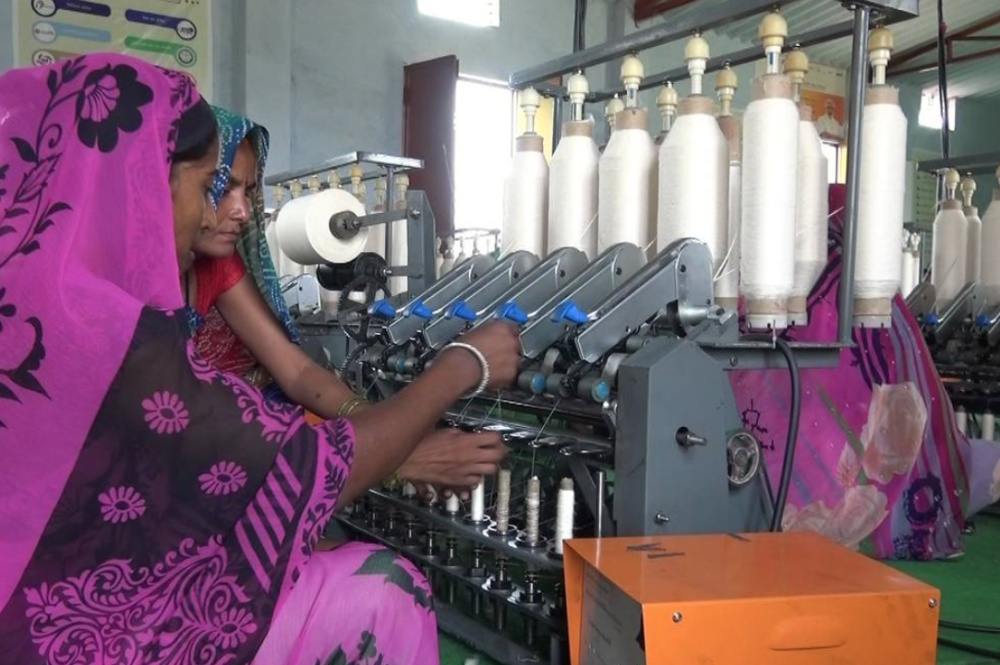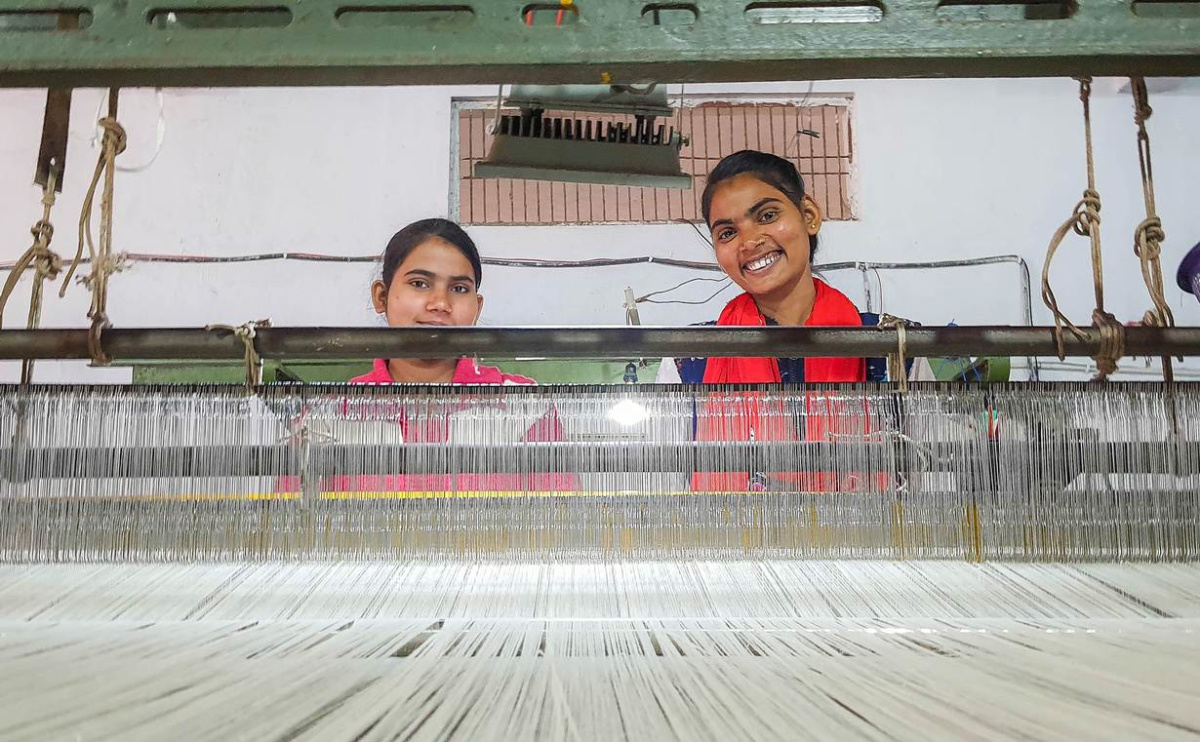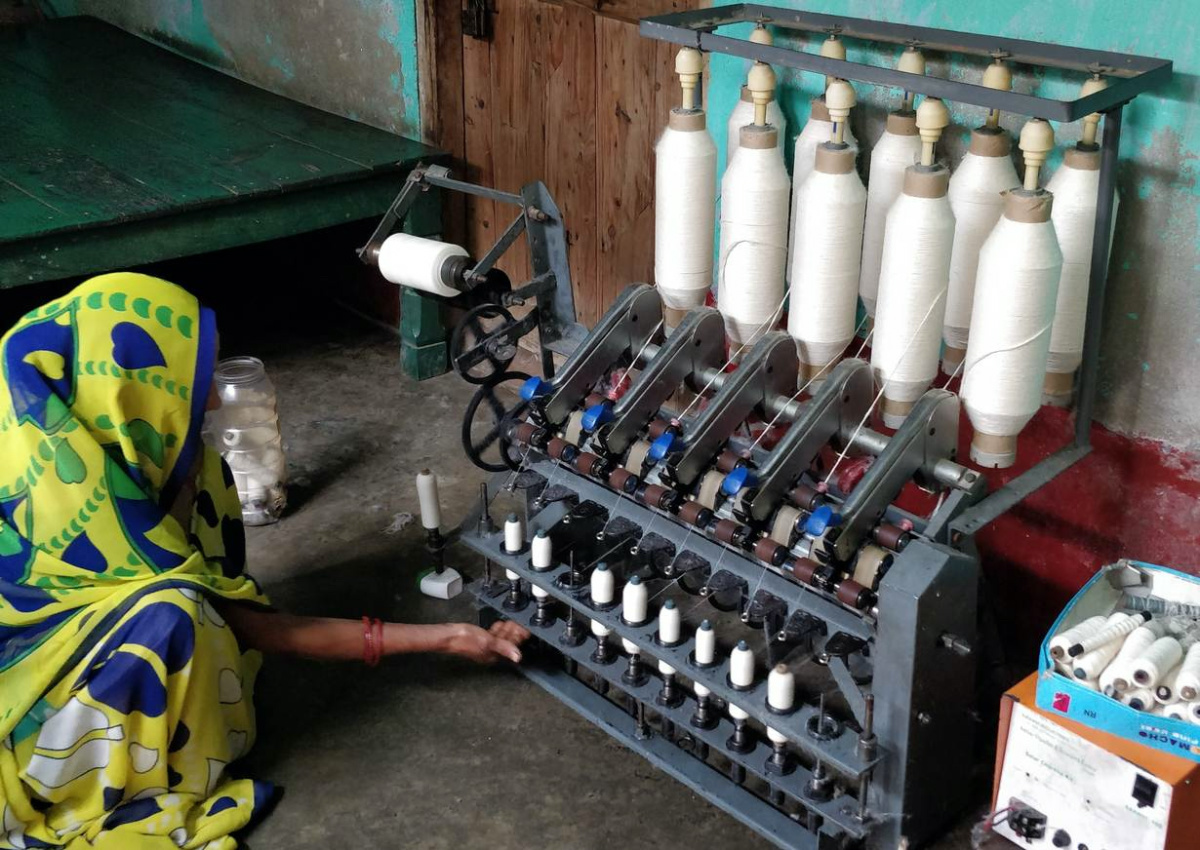
After the national Mission Solar Charkha project, MOUSHUMI BASU, of Thomson Reuters Foundation, reports how one Indian state is training female cotton spinners to use solar-powered wheels…
Moradabad, India
Thomson Reuters Foundation
As a traditional cotton spinner working from home in her village in northern India, Anita Devi was long resigned to having sore hands, meagre income and a constant struggle to make ends meet.
But her life changed in 2019 when the mother of two received a solar-powered spinning wheel, or charkha, as part of a drive by the state of Uttar Pradesh to boost rural women’s work opportunities and incomes in an environmentally-friendly manner.

Rural women spin on solar charkhas in Barabanki of Uttar Pradesh, India, on 20th April. PICTURE: Uttar Pradesh Khadi & Village Industries Board/Handout via Thomson Reuters Foundation.
The solar charkhas – which feature 12 spindles, double the number on Anita’s old wheel – are equipped with a motor and battery pack, and provided along with a 400 watt solar panel.
Anita, 34, produces up to 1.5 kilograms of cotton yarn daily using her solar charkha, up from 400 grams she spun with a traditional wheel, which has led to a more than fourfold increase in her monthly earnings – now at least 10,000 rupees ($US126) on average.
“With the additional income we can afford better nutrition, health care and even tuition for my children,” Anita told the Thomson Reuters Foundation at her home in Phoolpur village in Moradabad district.
Anita is one of about 4,000 women across villages in Uttar Pradesh – India’s most populous state and one of the poorest – who have been trained to use and provided with the solar charkhas in recent years under the state government initiative.
As India seeks to use less planet-heating coal to generate electricity and raise its renewables capacity to 500 gigawatts by 2030, up from about 115 GW now, Uttar Pradesh is looking to solar energy to power businesses, homes and communities, with a growing focus on those that are not connected to the grid.
Since 2018, solar charkhas worth 50,000 rupees have been distributed to about 1,000 women annually in Uttar Pradesh for free by the state’s Khadi and Village Industries Board (UPKVIB).
Many women work at home, while others do so at production hubs in their villages which are run by local non-profits.
Millions of people across India – mainly women from marginalised communities – do home-based textile work, but tend to go under the radar and miss out on minimum wage and benefits.
Navneet Sehgal, additional chief secretary at UPKVIB, said persuading rural and “patriarchal” households to allow women to attend solar charkha training had proved a challenge initially – but emphasised that the project was thriving after a slow start.
“It is so satisfying to see their numbers grow – on how they are working with confidence, enjoying more self-esteem and a bigger say in running their households,” he added.

Weavers from Sandoli village pose for a photo in Uttar Pradesh, India, on 25th May. PICTURE: Greenwear/Handout via Thomson Reuters Foundation
The project in Uttar Pradesh followed a separate nationwide 2018 scheme, ‘Mission Solar Charkha’, with the aim of providing the wheels to create jobs for up to 100,000 people – from spinners to stitchers – in 50 areas or ‘clusters’ across India.
In Uttar Pradesh’s independent programme, the solar charkhas are distributed via several grassroots non-profits.
One of them, Avad Yuva Kalyan Gramudyog Sansthan, also pays the women for the yarn they provide and has it woven into khadi – a traditional handspun fabric – by other female workers in its network before the items are finished off and then sold on.
“There is more awareness among these women today – be it either on…collective saving, helping each other during crisis, or sharing a line or two on the importance of solar energy in their lives,” said its founder Anil Kumar Singh.
UPKVIB said it gives financial aid to such organisations to ensure production is sustainable, and also helps them to showcase and sell their products at events across the country.
We rely on our readers to fund Sight's work - become a financial supporter today!
For more information, head to our Subscriber's page.
Local clothing companies such as Greenwear Fashion are also playing a role by training and employing hundreds of women to use not only solar-powered charkas but also looms and sewing machines, as well as by buying ‘solar yarn’ in bulk.
“It is not about making money alone, but our business should also come with a sustainable price tag of keeping the environment clean,” said Abhishek Pathak, founder of the social enterprise, which hails its entirely solar-focused value chain.
Rabia Khatoun, a weaver hired by the company during a COVID-19 lockdown in 2020 and provided with a solar-powered loom at a production centre it runs in Sarthara village, said she had doubled her productivity – and income – due to the equipment.
“Greenwear employed me during that crisis period, trained me on the use of solar loom and enabled me to sustain myself and my family,” added Khatoun, who said she was now earning between 10,000 and 12,000 rupees a month.
It is not just cotton spinners and weavers who are benefitting from solar energy in Uttar Pradesh.
Owners of small businesses, including oil and rice mills and an eatery, told the Thomson Reuters Foundation they had got a boost from solar power after using government-backed start-up bank loans, facilitated by UPKVIB, to fund their enterprises.

Anita Devi spins on her solar charkha in her home in Phoolpur village of Uttar Pradesh, India, on 25th May. PICTURE: Greenwear/Handout via Thomson Reuters Foundation
In Purey Udai village in Gonda district, Sangita Devi’s restaurant runs off five-kilowatt capacity solar panels, which power the lighting, five fans, a refrigerator and a submersible pump that draws underground water.
“My electricity bills are reduced to less than half, and with no more diesel costs, I could not have asked for more,” she said, explaining how her profits had since more than doubled.
The Uttar Pradesh New and Renewable Energy Development Agency said it had installed about 700 megawatts of solar off-grid capacity. Its total solar capacity state-wide is 2,200 MW.
Such off-grid installations include light for 60,000 homes in a dozen villages where grid power is hard to access, 300,000 street lights, and 20,000 irrigation pump sets for farmers.
“Off-grid solar applications can fit well into area-specific needs and penetrate any nook and corner of remote terrains,” said Shyam Dhar Dubey, senior project officer at UPNEDA.
However, Dubey said the high cost of maintaining solar panel systems could be a barrier to their long-term sustainability.
Nonetheless, in the case of the solar charkhas initiative, he hailed their impact on local women in a short space of time.
“Little did I realise that these could thus transform the lives of our rural women, making them self-reliant and environment-friendly,” he added.






